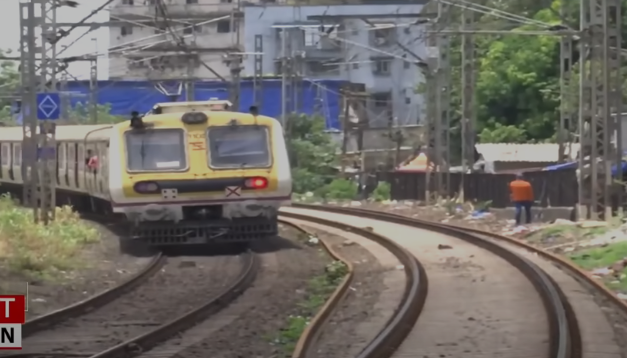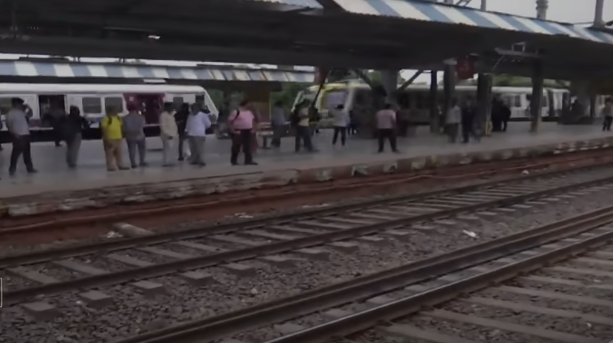A tragic Mumbai Train Accident near a sharp bend in the city has left four dead, and many others injured. Crowding and a dangerous curve are being blamed for the disaster, raising serious concerns about railroad safety.

What Happened in the Mumbai Train Accident?
On June 9, 2025, two local trains on the Central Railway line were involved in a tragic accident near a sharp bend. One train was travelling towards Chhatrapati Shivaji Maharaj Terminus (CSMT) and the other to Kasara. The speed of the trains and proximity of the tracks created a dangerous situation. Passengers hanging from footboards collided as they passed, resulting in four deaths, and multiple injuries to others.
The incident occurred at around 9:00 AM during peak rush hour, when trains are at their potential most crowded. Eyewitnesses have reported passengers hanging onto the doors, being hit by the other train and being ejected from the footboards to the ground. Emergency crews quickly transported the injured to hospitals including, Chhatrapati Shivaji Maharaj Hospital, and Jupiter Hospital.
Why the Sharp Curve is a Safety Hazard
The sharp curve is a known danger zone on Mumbai’s railway network. At this distance the trains on trains moving in opposite directions are only about 1.5-2 meters apart, and the tilt of the train meant the distance would be much less. All of these factors, alongside overcrowding, cause a significantly high risk to footboard passengers. An officer from the Railway Protection Force (RPF) commented that extra staff members are allocated to such curves, however due to the high volume of passengers and the force of impact, safety measures were unable to contain the incident. Swapnil Dhanraj Nila,
Central Railway’s Chief Public Relations Officer, stated that the incident was neither a collision nor a crash; it was a result of passengers on opposing trains footboards becoming tangled. The guard of the train bound for Kasara alerted the control room to the incident, which spurred a prompt and rapid response.
Victims and Immediate Response
Identities of the deceased have been determined to be Ketan Saroj, Rahul Gupta, Mayur Shah, and Government Railway Police (GRP) constable Vicky Mukhyad. At least nine others were injured, some of those critically. Maharashtra Chief Minister Devendra Fadnavis announced ₹5 lakh to the families of the deceased and promised the government would pay medical expenses to the injured. The Chief Minister called the incident “deeply unfortunate” and ordered a comprehensive investigation.
Images taken at the scene showed injured passengers lying across the tracks with blood and chaos evident. A local resident, Shiva, described seeing seven to nine people lying injured on the tracks as the trains sped around the curve simultaneously.

Overcrowding: The Persistent Challenge
More than 80 lakh passengers enter and exit Mumbai’s suburban railway, the city’s lifeline, every day. Overcrowding is a permanent feature, especially during peak hours, when passengers are routinely seen hanging from the doors and windows. Over the years, the Mumbai Railway Passengers Association has repeatedly chastised the Central Railway for prioritizing express runs as locos rather than local services and therefore compounding the already overflowing capacity. In total, from 2005 to July 2024, Mumbai’s suburban railways recorded 48513 deaths, owing to a myriad of causes, with falls from overcrowded trains being the most prevalent, followed closely behind by deaths from track crossings and pole collisions.
Railway Safety Initiatives
After the incident, the Railway Board promised to equip all new Mumbai rakes with automatic devices that will close doors, and eventually retrofit all existing ones. This is meant to stop people from hanging onto footboards. However, previous promises have been made and delayed, and adding infrastructure, such as increasing the number of footbridges is being delayed because of encroachments and vandalism. In Mumbai Railways 2024, the data showed there were 2,468 deaths and 2,697 injuries in Mumbai.
Public Outcry and Political Reactions
The tragic incident ignited anger among commuters and activists who demanded accountability and immediate safety measures. Shiv Sena MP Naresh Mhaske asked for an inquiry into whether overcrowding of commuters among other factors, contributed to that accident. BJP leader Kirit Somaiya pointed to Mumbai’s lack of infrastructure development in the suburbs. Posts on X revealed the public’s frustration with nearly everyone suggesting close-door trains instead. Maharashtra Minister Girish Mahajan implored railways to look into the risks of sharp curves where the incident occurred, while Chief Minister Fadnavis offered condolences and pledged to take action.
Looking Forward
The Mumbai train incident underscores the urgent need for systemic changes to the city’s railway system. Automatic doors, increased local train frequency, and safer design of tracks will be necessary to avoid needless deaths in the future. While investigations continue, the focus now must be on protecting its passengers, and regaining their trust in a critical aspect of Mumbai’s rail system.
Look out for updates on this evolving story while the authorities investigate this tragic situation.
